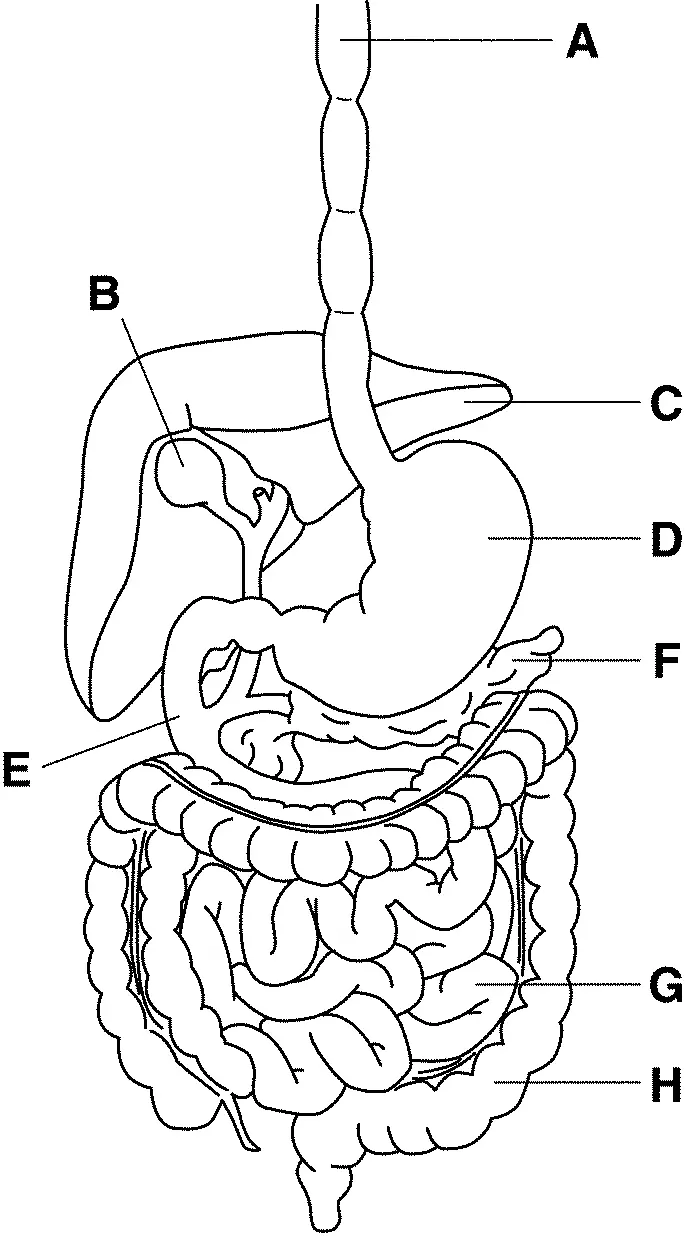Digestive System Anatomy: Diagram, Organs, Structures, & Functions

Yummy! The purpose of the digestive system is to break down food in order for your body to get nutrients.
Diagram of Digestive System Organs

First, quiz yourself and name the organs. See below in the structures and functions section for the answers. Then, using the diagram of the digestive system, the organs in the order in which food goes through the digestive system: A, D, E, G, H
The 3 organs that are NOT part of the digestive tract are: B, C, F
Food does not pass through these organs, instead they release liquids into the duodenum (E) to help with digestion.

Going through the digestive system:
Structures and Functions of Digestive System Organs
- Digestion begins in the mouth. Food is mechanically broken down by teeth and starch is chemically broken down by amylase into glucose.
- Structure A is the esophagus. Food moves through it by muscular contractions known as peristalsis. The epiglottis prevents food from going into the lungs instead.
- Structure D is the stomach. All food gets further broken down mechanically and the biomolecule protein is broken down chemically by the enzyme pepsin. HCl is released in the stomach to activate pepsinogen to become pepsin. In order to protect the stomach from the acidity of HCl, the stomach is lined with mucus.
- Structure C is the liver. It produces bile, which is then stored in structure B, the gall bladder. When released into the small intestine, this substance will help break down lipids into smaller particles. This is an example of mechanical
- Structure F is the pancreas. This organ releases a juice into the first part of the small intestine, called the duodenum. The juice released contains enzymes to help break down all biomolecules and sodium (hydrogen) bicarbonate to protect the small intestine by neutralizing the acid from the stomach.
- Structure G is the small intestine. Food is further broken down because of secretions from the pancreas and liver/gall bladder. Then the nutrients are absorbed through the villi and into the circulatory system where blood carries the nutrients to all of the cells in the body.
- Structure H is the large intestine. Here extra water is re-absorbed into the body leaving just the undigested food in the form of solid waste. Bacteria living here produce vitamins B & K. Waste is held in the rectum before is passes through the anus and out of the body.
FUN FACTS:
When there is cancer in the digestive system, the tumor often metastasizes to the supraclavicular fossa’s lymph nodes.
A person produces 2 pints of saliva a day.
The stomach can stretch to hold more than 1 liter of food.

Thanks for reading, and have a delicious day!
Copyright 2019 Moosmosis: All Rights Reserved
Please Like our Facebook page to support our open-access youth education initiatives! 🙂

Support Us at Moosmosis.org!
Thank you for visiting, and we hope you find our free content helpful! Our site is run 100% by volunteers from around the world. Please help support us by buying us a warm cup of coffee! Many thanks to the kind and generous supporters and donors for doing so! 🙂
$3.39
Works Cited
- National Digestive Diseases Information Clearinghouse. The digestive system. J Pract Nurs. 2010;60(2):7-9.
- Kalluri AG, Miao KH, Bordoni B. Anatomy, Shoulder and Upper Limb, Supraclavicular Fossa. In: StatPearls. Treasure Island (FL): StatPearls Publishing; May 20, 2020.
- DAVENPORT HW. Digestive system. Annu Rev Physiol. 1959;21:183-210. doi:10.1146/annurev.ph.21.030159.001151
- Soybel DI. Anatomy and physiology of the stomach. Surg Clin North Am. 2005;85(5):875-v. doi:10.1016/j.suc.2005.05.009
- Radtke F, Clevers H, Riccio O. From gut homeostasis to cancer. Curr Mol Med. 2006;6(3):275-289. doi:10.2174/156652406776894527















89 replies »